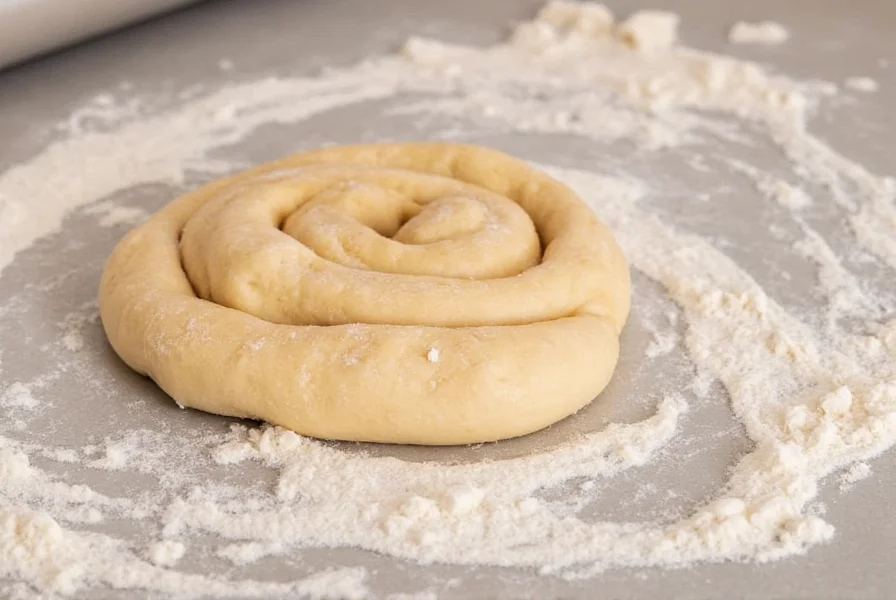Essential Components of Quality Cinnamon Roll Dough
Creating exceptional cinnamon roll dough requires understanding how each ingredient contributes to the final product. Unlike basic bread dough, cinnamon roll dough needs specific characteristics to support the filling while maintaining structure during baking.
Why Ingredient Quality Matters
Using fresh yeast is non-negotiable for proper dough for cinnamon rolls development. Old or expired yeast won't provide the necessary rise, resulting in dense, heavy rolls. Always check your yeast's expiration date and consider proofing it in warm milk with a pinch of sugar before incorporating other ingredients.
The type of fat used significantly impacts texture. Unsalted butter provides superior flavor and control over salt content compared to margarine or shortening. For the best dough for cinnamon rolls, use high-quality European-style butter with higher fat content for richer flavor and better lamination.

Step-by-Step Cinnamon Roll Dough Preparation
Follow this professional technique for cinnamon roll dough recipe that actually works. The key is temperature control and proper gluten development.
- Mix wet ingredients: Combine warm milk (110°F), melted butter, egg, and 1 tbsp sugar. The temperature is critical—too hot kills yeast, too cold won't activate it.
- Bloom yeast: Mix yeast with 1/4 cup flour and 1 tbsp sugar, then add to wet ingredients. Let sit 5-10 minutes until foamy.
- Combine dry ingredients: Whisk flour, remaining sugar, and salt in separate bowl.
- Form dough: Gradually add dry ingredients to wet, mixing until shaggy dough forms.
- Knead properly: Knead 8-10 minutes by hand or 5-7 minutes in stand mixer until smooth, elastic, and passes windowpane test.
- First rise: Place in greased bowl, cover, and let rise at room temperature (75-80°F) for 1-1.5 hours until doubled.
Troubleshooting Common Dough Problems
Even experienced bakers encounter issues with how to make cinnamon roll dough from scratch. Here's how to fix common problems:
| Problem | Causes | Solutions |
|---|---|---|
| Dough won't rise | Cold environment, dead yeast, too much sugar | Check yeast freshness, maintain 75-80°F environment, verify liquid temperature |
| Dough too sticky | Excess liquid, insufficient kneading | Add flour 1 tbsp at a time during kneading, avoid over-flouring work surface |
| Rolls too dense | Over-kneading, improper rising, old yeast | Stop kneading when windowpane test passes, don't punch down too aggressively |
Professional Techniques for Superior Results
Master bakers use several advanced methods for the soft cinnamon roll dough recipe that delivers consistent results:
- Temperature-controlled rising: Maintain 75-80°F environment using oven with light on or near warm appliance
- Windowpane test: Stretch small piece of dough—if it forms translucent membrane without tearing, gluten is properly developed
- Chilled rolling: Refrigerate dough 15-20 minutes before rolling for cleaner cuts and less sticking
- Butter temperature: Use cool but pliable butter for filling to prevent melting into dough

Variations for Special Dietary Needs
Adapting cinnamon roll dough rising tips for different dietary requirements requires specific adjustments:
Whole wheat version: Substitute up to 50% of all-purpose flour with white whole wheat flour. Increase liquid by 2-3 tbsp and allow additional 15-20 minutes rising time due to bran's interference with gluten development.
Gluten-free adaptation: Use quality gluten-free flour blend with xanthan gum. Add 1 tsp apple cider vinegar to improve rise and texture. Expect slightly denser result but still delicious with proper technique.
Storage and Freezing Techniques
Proper handling of prepared cinnamon roll dough recipe extends freshness and convenience:
- Refrigerated dough: Store shaped but unbaked rolls in airtight container for up to 24 hours. Let sit at room temperature 30 minutes before baking.
- Overnight method: After first rise, punch down dough, shape rolls, place in pan, cover, and refrigerate. Bake straight from fridge, adding 5-7 minutes to baking time.
- Freezing unbaked: Freeze shaped rolls on parchment-lined baking sheet, then transfer to freezer bags. When ready to bake, thaw overnight in refrigerator then proceed with recipe.
Frequently Asked Questions
Can I use instant yeast instead of active dry yeast for cinnamon roll dough?
Yes, you can substitute instant yeast for active dry yeast at a 1:1 ratio. The main difference is instant yeast can be mixed directly with dry ingredients without blooming. When using instant yeast, you may notice slightly faster rise times—check dough 15-20 minutes earlier than recipe indicates.
Why do my cinnamon rolls separate from the dough during baking?
This separation occurs when the filling is too wet or the dough hasn't properly sealed the edges. Use room temperature butter (not melted) for filling, spread evenly but leave 1/2 inch border at long edge, and pinch seam firmly before cutting. Chilling the rolled dough for 15 minutes before slicing also helps maintain structure.
How can I tell when cinnamon roll dough has risen enough?
Properly risen dough will be approximately double its original size. Gently press two fingers into the dough—if the indentation remains without springing back completely, it's ready. If it springs back immediately, it needs more time. If the indentation remains and the dough feels fragile, it's over-risen. Ideal rise time varies by temperature and humidity.
Can I make cinnamon roll dough without a stand mixer?
Absolutely. While a stand mixer with dough hook makes the process easier, you can successfully make dough for cinnamon rolls by hand. Mix ingredients in large bowl, then turn onto lightly floured surface. Knead using heel of hand, folding dough toward you, for 8-10 minutes until smooth and elastic. Proper hand-kneading develops gluten structure just as effectively as machine mixing.











 浙公网安备
33010002000092号
浙公网安备
33010002000092号 浙B2-20120091-4
浙B2-20120091-4